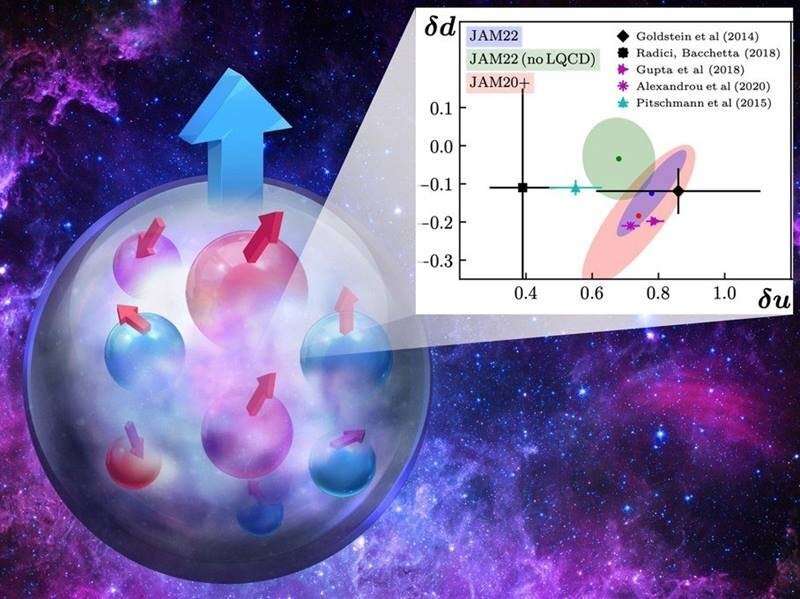This article has been reviewed according to Science X's editorial process and policies. Editors have highlighted the following attributes while ensuring the content's credibility:
fact-checked
peer-reviewed publication
trusted source
proofread
Zeroing in on a fundamental property of the proton's internal dynamics

Inside the proton are elementary particles called quarks. Quarks and protons have an intrinsic angular momentum called spin. Spin can point in different directions. When it is perpendicular to the proton's momentum, it is called a transverse spin. Just like the proton carries an electric charge, it also has another fundamental charge called the tensor charge. The tensor charge is the net transverse spin of quarks in a proton with transverse spin.
The only way to obtain the tensor charge from experimental data is using the theory of quantum chromodynamics (QCD) to extract the "transversity" function. This universal function encodes the difference between the number of quarks with their spin aligned and anti-aligned to the proton's spin when it is in a transverse direction. Using state-of-the-art data science techniques, researchers recently made the most precise empirical determination of the tensor charge.
Due to the phenomenon known as confinement, quarks are always bound in the proton or other hadrons (particles with multiple quarks). The challenge is to connect the theory of quark interactions (QCD) to experimental measurements of high-energy collisions involving hadrons.
Researchers from the Coordinated Theoretical Approach to Transverse Momentum Dependent Hadron Structure in QCD Topical Collaboration (TMD Collaboration), working in conjunction with the Thomas Jefferson National Accelerator Facility (Jefferson Lab) Angular Momentum Collaboration (JAM Collaboration), analyzed data from a wide range of experiments where protons and/or quarks were transversely polarized. This allowed for the most precise empirical determination of the proton's tensor charge. The tensor charge is not only a fundamental property of the proton but also needed in searches for new physics.
The results were then compared to computations of the proton's tensor charge by lattice QCD, which simulates the proton's structure on a supercomputer. After about a decade of results showing disagreement between empirical methods and lattice QCD for the proton's tensor charge, researchers for the first time found agreement between the two. Their findings are published in the journal Physical Review D.
The empirical study was performed using QCD theory and state-of-the-art numerical methods. A crucial part of the analysis was the utilization of data from electron–positron, electron–proton, and proton–proton scattering. This opens a new frontier in QCD global analyses to simultaneously include all possible measurements, like those from the future Electron-Ion Collider and Jefferson Lab 12 GeV, to continue to increase the precision and accuracy of extracting the proton's tensor charge.
More information: Leonard Gamberg et al, Updated QCD global analysis of single transverse-spin asymmetries: Extracting H˜ , and the role of the Soffer bound and lattice QCD, Physical Review D (2022). DOI: 10.1103/PhysRevD.106.034014
Journal information: Physical Review D
Provided by US Department of Energy





















